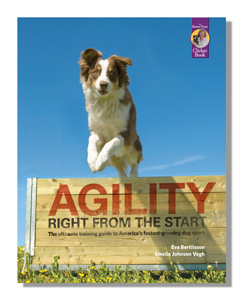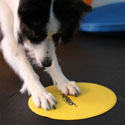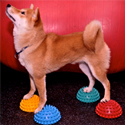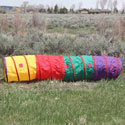In their highly anticipated new book, Agility Right from the Start, Eva Bertilsson and Emelie Johnson Vegh present a comprehensive guide to agility, based entirely on the powerful modern training system that made them leading agility teachers throughout Norway and Sweden.
Advance readers comment:
“Talk about a training bible--this book has it all….the authors’ purely positive approach and sense of fun would get anybody excited to learn agility! I will never start a puppy again without referring to this book.” —Leslie McDevitt, MLA, CPCT, CDBC

The authors “…have a deep understanding of the science and a great passion for training. This book takes the reader through a truly systematic approach that I believe all trainers will find extremely valuable…” —Ken Ramirez, vice president, Shedd Aquarium, Chicago, author, Animal Training: Successful Animal Management through Positive Reinforcement
“From the start you understand your job and your dog’s job and learn how to communicate clearly with your teammate. Eva and Emelie never leave you hanging; you always know what the next step in training is.” —Marty Becker, DVM, “America’s Veterinarian,” veterinary contributor to ABC-TV’s Good Morning America and The Doctor Oz Show, co-author, Chicken Soup for the Pet Lover’s Soul
Excerpt from Chapter One, Introduction
Building blocks for agility
Our goal—a happy and confident team that can get around the agility course with flow, speed, and precision—informs and influences our training, our teaching, and the structure of this book.
1. You need to develop your theoretical understanding and knowledge of dogs, training, and agility.
As your dog’s teammate and teacher, you’re in charge of the training process: the path to a happy and confident dog goes through you. The more you know and understand about dogs, training, and agility, the easier it will be to decide what to train (both what your ultimate goals are, and which steps you can take to get there) and how to train.
Derived from the laws of learning, clicker training provides us with a clear outline for how to train: focus on behavior, use positive reinforcement, and build behavior step-by-step.
All our training is based on the principles of clicker training. Derived from the laws of learning, clicker training provides us with a clear outline for how to train: focus on behavior, use positive reinforcement, and build behavior step-by-step. Foundation training thus becomes our top priority because that is where both you and your dog get to work on one aspect at a time, which enables you to gain success right from the start. Throughout this book, we aim to provide you with an understanding of the underlying principles of clicker training and how to use them in your agility training. The more you learn about positive reinforcement training, the better equipped you’ll be to design your own training program, reach your goals, and resolve any problems that might arise during the process.
All our training is also based on our conviction that everything in and around the training situation should happen in a manner that is appropriate to agility. No matter what you’re training at the moment, you should always make sure to work with maximum focus and full intensity, and to follow your system of handling. We refer to these rules as Good Agility Practices. Along with the principles of clicker training, Good Agility Practices provide the framework for our training.
Accordingly, the first part of this book addresses the theoretical underpinnings that guide our training.
2. You and your dog need to learn foundation skills.
The most important part of practical agility training is laying a solid foundation. It’s like building a house or learning arithmetic. The genius is in the details, which means that you need to start with the basics. Foundation skills form the core of agility, so you’ll revisit them over and over throughout your agility career to refresh, maintain, and refine them.
For your dog, foundation training is all about learning to love the game of agility. He’ll learn to work with focus and intensity, offering behaviors and earning rewards.
What kind of foundation training are we talking about, then? For you, it entails acquiring the skills needed to train your dog so that you can get the behaviors you want, and establishing the basics of handling so that you can move around smoothly with your dog during and between exercises. Applying the principles of positive reinforcement, we employ TAGteach to help you learn these basic skills. (TAGteach is discussed further in Chapter 3.)
For your dog, foundation training is all about learning to love the game of agility. He’ll learn to work with focus and intensity, offering behaviors and earning rewards. Some examples of foundation skills you might work on during your agility training are: reward procedures (like running to a treat bowl or playing tug); working on both your left and your right sides; going between, over, and under things; developing body awareness; and liking and creating noise and movement. You can practice foundation skills virtually anywhere, and the good news is that you need neither a lot of space nor any formal agility equipment to do it.
We know that the equipment on the agility course can be very tempting! To maximize happiness and confidence throughout the training process, however, it’s best to split your training into smaller segments and work on one thing at a time, building a proper foundation. There’s no denying that thorough work on the basics will delay your first try at running a full course, but proper grounding in the basics is the only way to ensure that both you and your dog will get it right from the start, avoid rehearsing bad habits, have fun, and be successful all through the process. Later, when you start working on handling maneuvers and teaching the different obstacles (and eventually begin running obstacle sequences and courses), you’ll easily put the pieces together and reap the fruits of your excellent foundation work.
The second part of our book presents an array of basic skills that will give you and your dog the foundations necessary to play agility. Because you are the path to your dog’s learning, we start with you. Once you have the methods and mechanics of training and handling under your belt, we move on to your dog.
3. You need to put it all together.
Soon enough the time will come for dog and handler to get onto the agility field and start working on handling maneuvers and obstacles. This is where all your foundation training really pays off!
If you’ve built a strong foundation, you’ll be amazed at how quickly your dog becomes proficient on the various pieces of agility equipment. Because you’ve already established your own training and handling mechanics, you’ll be able to keep up with your dog’s progress. Before you know it, you and your dog will be zooming through obstacle sequences—your dog performing each piece of equipment independently and you directing his path between the obstacles.
The third part of the book shows you how to combine all those foundation skills to teach your dog to follow your handling and to perform the agility obstacles in sequences.
Agility Right from the Start is available in March 2010 at the clickertraining.com store.







yay
looking foward to by this, hopefully it'll come out in barnes and nobels
Post new comment